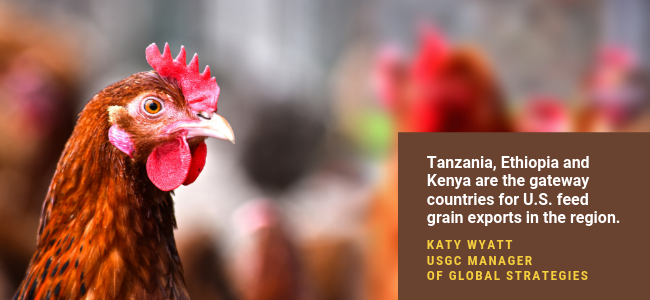Industry associations can provide a powerful voice for producers and users of agricultural goods, not just in the United States, but globally. Recognizing the role associations can play in supporting producers and ensuring the safety and quality of end-products, the U.S. Grains Council (USGC) is working to empower poultry and feed associations in East Africa – including Tanzania, Kenya and Ethiopia – with the goal of building future demand for coarse grains and co-products.
“Tanzania, Ethiopia and Kenya are the gateway countries for U.S. feed grain exports in the region,” said Katy Wyatt, USGC manager of global strategies, who recently returned from an assessment mission to the region. “All three countries have rapidly changing dynamics in their feed industries that will affect regional trade and will ultimately affect future grain imports.
“The Council is able to leverage existing operations through the office in Tanzania to target market opportunities for U.S. feed grain exports and livestock sector development in this region.”
The poultry chain requires a consistent supply of reliable raw materials, feed ingredients, day-old chicks, veterinary services and supportive government regulations. Feed costs constitute upwards of 80 percent of production costs within the poultry industry in East Africa. Currently, corn shortages in the region, largely the result of two years of regional drought conditions, are driving up the cost of this feed even further – making it difficult for the industry to match rising demand for poultry and egg products.
Demand for meat, milk and eggs in Africa is expected to quadruple by 2050, driven by changing demographics, rapid population growth and increased standards of living. East Africa has one of the largest rural populations on the continent and is projected to experience a faster rate of urbanization compared to other developing regions. This need is already noticeable in the region, and poultry and feed industries are struggling to meet the growing demand for poultry and egg products.
To assist producers with meeting these challenges, the Council has engaged with the Poultry Association of Tanzania (PAT) for the past six years. The PAT is a 10-member umbrella association that represents the entirety of the poultry value chain, from broiler and layer producers to breeders and feed manufacturers. The PAT strives to support the development of the Tanzanian poultry industry by providing market information, technical assistance and industry updates.
“In times when poultry producers face difficulties, it is imperative that producers can effectively communicate the challenges and constraints hindering both current and future production,” said Wyatt. “For this reason, having effective poultry associations that represent the interests of poultry producers is critical.”
A key effort of the PAT’s engagement is advocating for government policies and regulations for the betterment of the poultry industry. Still early in the organization’s development, the PAT has already demonstrated the impact a collective voice can have on government policies, successfully pushing the government of Tanzaniain 2017 to remove a cost-prohibitive, 18 percent value-added tax on the sale of animal feed that strained production costs.
Armed with funding from the U.S. Department of Agriculture’s (USDA’s) Agricultural Trade Promotion (ATP) program, the Council is expanding these efforts to work with regional poultry associations to address key constraints and bottlenecks hindering development within the poultry industries in Kenya and Ethiopia – furthering the Council’s overall mission to develop markets, enable trade and improve lives.
“The East African market is complex and needs extensive engagement to build effective marketing programs that address constraints to U.S. exports,” Wyatt said. “Improving overall feed production and highlighting the significant growth opportunities to industry partners will continue to introduce U.S. suppliers to these markets and solidify future trading relationships.”
About The U.S. Grains Council
The U.S. Grains Council develops export markets for U.S. barley, corn, sorghum and related products including distiller’s dried grains with solubles (DDGS) and ethanol. With full-time presence in 28 locations, the Council operates programs in more than 50 countries and the European Union. The Council believes exports are vital to global economic development and to U.S. agriculture’s profitability. Detailed information about the Council and its programs is online at www.grains.org.

